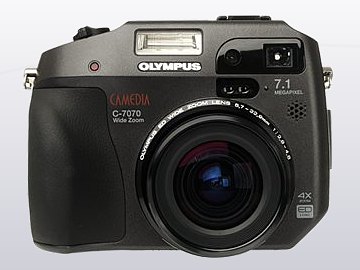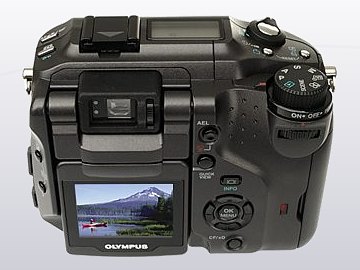
|
Olympus Camedia C-7070WZ A better '5060? |

| My other pages related to the Olympus C-5050Z, C-5060WZ, and X-7070WZ |
|
Following a number of requests from Readers, here is a very brief discussion for the C-7070WZ digital camera from Olympus. It is not a full review, as the '7070 is a non-identical clone of the previous model, C-5060WZ, from which it differs only in a very few specs and features. Because of that, here I will focus on differences between two models, as my '5060 review has been updated to become fully applicable to the newer model. Keep in mind that I had the '7070 only for a weekend, being unable to come up with any meaningful image samples. For comparisons and trial prints I used the samples provided by Steve's Digicams, being among the most consistent ones available on the 'Net. |

|

| |
| Pictures from promotional materials by Olympus. | ||
|
More pixels The main difference between the both cameras is that the new model has a sensor with more pixels. Here is a detailed comparison, with the '5060 numbers in parentheses.
This means that the increase in pixel count is about 41%, which translates itself into a 20% increase in print sizes possible at similar quality (assuming the lens is good enough). In reality, this is usually not the case. Still, the images from the '5060 can be converted into good prints at 12×16" (30×40 cm), large enough for my needs, and the '7070 can only do better. More pixels at the same imager size means smaller pixels. Smaller pixels mean more image noise — but most people overlook the fact that this is more noise per pixel, not per print area unit. At the same print size, the '7070 noise is less magnified (by 20%), and I could not really see a difference here between both cameras. Camera construction and layout The body design and construction quality are the same as in the '5060, where they were very good, except for a design error, causing the infamous mode dial problem which seemed to be quite common. Obviously, the problem has been addressed in the '7070, as I haven't heard from anyone suffering from it. Anyway, the '7070 has the same sturdy all-metal body (magnesium alloy) and well-placed controls. The body is a tad too large for my taste, but, still, I like it. The only visible difference, in addition to the new logo, is that individual "scene modes" have been removed from the mode dial and replaced with just one position, marked as "Scene"; the actual choice is done from the menu system. The redesign might have been needed to get rid of the problem mentioned above, but I actually prefer it this way. Overall, a professional-grade job, hard to match by anyone else. Minor modifications These are mostly of secondary importance or even less; I consider only the first one relevant.
Conclusions As you could see, the list of changes is rather short. This is good news, as the '5060 is a very good camera, and there was no real reason to change anything (except of fixing the mode dial problem), unless Olympus decided to address one of the larger issues, providing the new model with a better viewfinder and/or increasing the lens aperture at the long end. This would, however, make the '7070 an entirely new design. On the other hand, the market grew used to having a new, "improved" model of the same line every year, and I think Olympus was desperate to come up with one. Throwing in more megapixels is not so expensive, neither are the other improvements we have seen. Besides, the '7070 dose not carry the malodorous stigma of the mode dial problem. All this aside, the C-7070WZ would be still my top choice for a user who needs a pro-grade, non-SLR model for good handling, full control, and serious results. Availability The '7070 became available around February, 2005. As of this writing (early October) it seems like the camera has disappeared from most stores (this was preceded by a price rise, at least at B&H). It is no longer listed by two biggest U.S. merchants: B&H and Adorama, although the Japanese and U.S. Olympus Web sites still show it among current products. We may suspect that Olympus decided to pull the plug on the '7070, for reasons unknown. Maybe the model was offering too narrow profit margin: good lens, all-metal body, solid construction — most of that wasted on the mass market anyway. The recently announced SP-310 and SP-350 from Olympus (7 and 8 MP, respectively) are clearly addressed at the less-demanding market, with the zoom lens starting at only 38 mm (not 28, a huge difference!) and the body construction being a far cry from the '5060 or '7070. The new models may be more appealing to a typical consumer, but I'm not thrilled with them at all, in spite of larger and more readable LCD monitors. My advice: if you need a serious non-SLR camera, try to find a dealer who still has the '7070 in stock and snatch it before someone else does. |

| My other pages related to the Olympus C-5050Z, C-5060WZ, and X-7070WZ |
|
Camedia® and Olympus® are registered trademarks of Olympus Corporation.
This page is not sponsored or endorsed by Olympus (or anyone else) and presents solely the views of the author. |
| Home: wrotniak.net | Search this site | Change font size |
| Posted 2005/10/01; last updated 2005/11/28 | Copyright © 2005 by J. Andrzej Wrotniak |